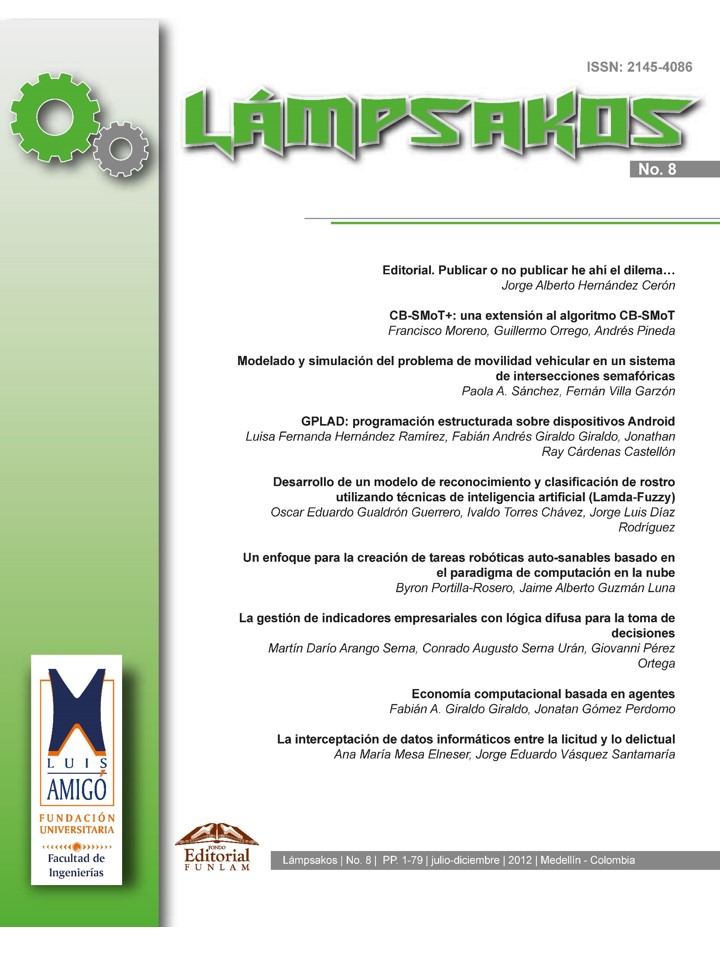UN ENFOQUE PARA LA CREACIÓN DE TAREAS ROBÓTICAS AUTOSANABLES BASADO EN EL PARADIGMA DE COMPUTACIÓN EN LA NUBE
DOI:
https://doi.org/10.21501/21454086.677Keywords:
Análisis de fallas, Computación en la nube, Control de robots,Abstract
Cada día se implementan nuevas tecnologías para dar solución a los requerimientos de los usuarios. Tal es el caso de la computación en la nube, que se basaba en el principio de ofrecer servicios a los clientes a través de la Internet y pueden ser accedidos desde cualquier lugar o sistema. Esta tecnología se ha puesto en marcha en varias áreas del conocimiento para dar soluciones a diversos problemas de carácter tecnológico o estructural. En este artículo se presenta una visión preliminar del estado en el que se encuentra la computación en la nube asociada con la robótica y cómo puede ser utilizada como medio de análisis para la creación de tareas robóticas.Downloads
References
Y. Chen, Z. Du y M. García-Acosta, «Robot as a Service in Cloud Computing,» International Symposium on Service Oriented System Engineering, pp. 151-158, 2010.
S. Sharee, B. Laster, O. Ayodeji y B. Olatunji, «Autonomic Computing: Towards a Self-Healing System,» Proceedings of the Spring 2007 American Society for Engineering Education Illinois-Indiana Section Conference, 2007.
J. McCann y M. Huebscher, «A survey of Autonomic Computing - degrees, models and applications,» Journal ACM Computing Surveys (CSUR), vol. 40, nº 3, 2008.
I. Al-oqily, S. Bani-Mohammad, B. Subaih y J. J. Alshaer, «A Survey for Self-Healing Architectures and Algorithms,» Systems, Signals and Devices (SSD), pp. 1-5, 2012.
C. Bettini, O. Brdiczka, K. Henricksen, J. Indulska, D. Nicklas, A. Ranganathanf y D. Riboni, «A survey of context modelling and reasoning techniques,» Pervasive and Mobile Computing, pp. 161-180, 2010.
K. Henricksen y J. Indulska, «Modelling and using imperfect context information,» in: 1st Workshop on Context Modeling and Reasoning (CoMoRea), 2004. [7] K. Henricksen y J. Indulska, «Developing context- aware pervasive computing applications: Models and approach,» Pervasive and Mobile Computing, pp. 37-64, 2006.
B. Schilit, N. Adams y R. Want, «Contextaware Computing Applications,» Mobile Computing Systems and Applications, pp. 85-90, 1994.
A. Dey, «Understanding and using context,» Personal and Ubiquitous Computing, 2001.
A. Frank, «Tiers of ontology and consistency constraints in geographical information systems, » International Journal of Geographical Information Science, vol. 15, nº 7, pp. 667- 678, 2001.
C. Becker y F. Dürr, «On location models for ubiquitous computing,» Personal and Ubiquitous Computing, vol. 9, nº 1, pp. 20-31, 2005.
F. Baader, D. Calvanese, D. McGuinness, D. Nardi y P. Patel-Schneider, The Description Logic Handbook: Theory, Implementation, and Applications, Cambridge University Press, 2003.
Y. Ha, J. Sohn y Y. Cho, «Service-oriented integration of networked robots with ubiquitous sensors and devices using the semantic Web services technology,» Conference on Intelligent Robots and Systems (IROS 2005), vol. 2, nº 6, p. 3947 – 3952, 2005.
A. Yachir, K. Tari, A. Chibani y Y. Amirat, «Towards an Automatic Approach for Ubiquitous Robotic Services Composition,» International Conference on Intelligent Robots and Systems, pp. 3717-3724, 2008.
A. Yachir, K. Tari, Y. Amirat, A. Chibani y N. Badache, «QoS Based Framework for Ubiquitous Robotic Services Composition,» International Conference on Intelligent Robots and Systems, pp. 2019-2026, 2009.
V. Trifa, C. Cianci y D. Guinard, «Dynamic Control of a Robotic Swarm using a Service- Oriented Architecture,» 13th International Symposium on Artificial Life and Robotics (AROB 2008), 2008.
Z. Du, W. Yang, Y. Chen, X. Sun, X. Wang y C. Xu, «Design of a Robot Cloud Center,» Tenth International Symposium on Autonomous Decentralized Systems, pp. 261-275, 2011.
R. Arumugam, V. R. Enti, L. Bingbing, W. Xiaojun, K. Baskaran, F. F. Kong, S. Kumar, K. D. Meng y G. W. Kit, «DAvinCi: A Cloud Computing Framework for Service Robots,» International Conference on Robotics and Automation, pp. 3084-3089, 2010.
E. Sirin, B. Parsia, D. Wu, J. Handler y D. Nau, «HTN planning for web service composition using SHOP2,» Web Semantics, vol. 1, nº 4, pp. 377-396, 2004.
A. Blum y M. Furst, «Fast planning through planning graph analysis,» Artificial Intelligence, vol. 90, pp. 281-300, 1997.
Downloads
Published
How to Cite
Issue
Section
License
In accordance with national and international copyrights, as well as publishing policies of "Fundación Universitaria Luis Amigó" and its Journal "Lámpsakos" (indexed with ISSN : 2145-4086), I (we ) hereby manifest:1. The desire to participate as writers and submit to the rules established by the magazine publishers.
2. The commitment not to withdraw the manuscript until the journal finishes the editing process of the ongoing issue.
3. That article is original and unpublished and has not been nominated or submitted together in another magazine; therefore, the rights of the article in evaluation have not been assigned in advance and they do not weigh any lien or limitation for use.
4. The absence of conflict of interest with commercial institution or association of any kind
5. The incorporation of the quotes and references from other authors, tending to avoid plagiarism. Accordingly, the author affirms that the paper being published do not violate copyright, intellectual property or privacy rights of third parties. Morover, if necessary there is a way of demonstrating the respective permits original copyright to the aspects or elements taken from other documents such as texts of more than 500 words, tables, graphs, among others. In the event of any claim or action by a third party regarding copyright on the article, the author (s) will assume full responsibility and come out in defense of the rights herein assigned. Therefore, for all purposes, the Journal "Lámpsakos" of the "Fundación Universitaria Luis Amigó" acts as a third party in good faith.
6. In the event of the publication of the article, the authors free of charge and on an exclusive basis the integrity of the economic rights and the right to print, reprint and reproduction in any form and medium, without any limitation as to territory is concerned, in favor of the Journal "Lámpsakos" of the "Fundación Universitaria Luis Amigó".








